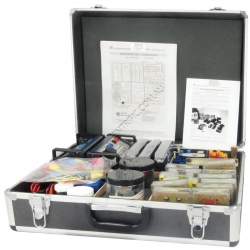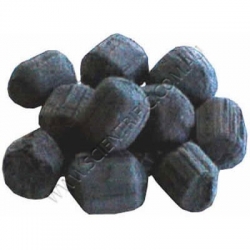34 results found for 'Plain'. Prev |1|2 | Next | View 100 per page
Low relevance matches: 22 other results may be of interest to you. Show low relevance matches
Evolution - The theory of evolution by natural selection explains the diversity of living things and is supported by a range of scientific evidence ACSSU151 Year 8 Chemical Sciences
Matter and Particles - The properties of the different states of matter can be explained in terms of the motion and arrangement of particles ACSSU180 Year 9 Earth and Space Sciences
Plate Tectonics - The theory of plate tectonics explains global patterns of geological activity and continental movement ACSSU182 Year 9 Physical Sciences
Energy Transfer - Energy transfer through different mediums can be explained using wave and particle models ACSSU188 Year 10 Earth and Space Sciences
Universe - The universe contains features including galaxies, stars and solar systems and the Big Bang theory can be used to explain the origin the universe ACSSU190 Year 10 Physical Sciences
Energy Conservation - Energy conservation in a system can be explained by describing energy transfers and transformations ACSCH032 Year 11 Chemical fundamentals
Properties and structure of materials - The characteristic properties of metals (for example, malleability, thermal conductivity, electrical conductivity) are explained by modelling metallic bonding as a regular arrangement of positive ions (cations) made stable by electrostatic forces of attra ACSCH037 Year 11 Chemical fundamentals
Chemical reactions - Endothermic and exothermic reactions can be explained in terms of the Law of Conservation of Energy and the breaking and reforming of bonds; heat energy released or absorbed can be represented in thermochemical equations ACSCH056 Year 11 Molecular interactions and reactions
Intermolecular forces and gases - The shapes of molecules can be explained and predicted using three dimensional representations of electrons as charge clouds and using valence shell electron pair repulsion (VSEPR) theory ACSCH060 Year 11 Molecular interactions and reactions
Intermolecular forces and gases - The behaviour of gases, including the qualitative relationships between pressure, temperature and volume, can be explained using kinetic theory ACSCH065 Year 11 Molecular interactions and reactions
Aqueous solutions and acidity - The solubility of substances in water, including ionic and molecular substances, can be explained by the intermolecular forces between species in the substances and water molecules, and is affected by changes in temperature ACSCH098 Year 12 Equilibrium acids and redox reactions
Chemical equilibrium systems - The strength of acids is explained by the degree of ionisation at equilibrium in aqueous solution, which can be represented with chemical equations and equilibrium constants (Ka) ACSCH099 Year 12 Equilibrium acids and redox reactions
Chemical equilibrium systems - The relationship between acids and bases in equilibrium systems can be explained using the Brønsted Lowry model and represented using chemical equations that illustrate the transfer of hydrogen ions ACSPH076 Year 11 Linear Motion and Waves
Waves - A wave model explains a wide range of lightrelated phenomena including reflection, refraction, total internal reflection, dispersion, diffraction and interference; a transverse wave model is required to explain polarisation ACSPH137 Year 12 Revolutions in modern physics
Quantum theory - A wide range of phenomena, including black body radiation and the photoelectric effect, are explained using the concept of light quanta ACSPH139 Year 12 Revolutions in modern physics
Quantum theory - The Bohr model of the hydrogen atom integrates light quanta and atomic energy states to explain the specific wavelengths in the hydrogen spectrum and in the spectra of other simple atoms; the Bohr model enables line spectra to be correlated with atomic en ACSCH031 Year 11 Chemical fundamentals
Properties and structure of materials - The properties of ionic compounds (for example, high melting point, brittleness, ability to conduct electricity when liquid or in solution) are explained by modelling ionic bonding as ions arranged in a crystalline lattice structure with forces of attract ACSCH027 Year 11 Chemical fundamentals
Properties and structure of atoms - The type of bonding within substances explains their physical properties, including melting and boiling point, conductivity of both electricity and heat, strength and hardness ACSPH071 Year 11 Linear Motion and Waves
Waves - The mechanical wave model can be used to explain phenomena related to reflection and refraction







34 results found for 'Plain'. Prev |1|2 | Next | View 100 per page
Low relevance matches: 22 other results may be of interest to you. Show low relevance matches
Curriculum resources related to 'Plain'
ACSSU185 Year 10 Biological SciencesEvolution - The theory of evolution by natural selection explains the diversity of living things and is supported by a range of scientific evidence ACSSU151 Year 8 Chemical Sciences
Matter and Particles - The properties of the different states of matter can be explained in terms of the motion and arrangement of particles ACSSU180 Year 9 Earth and Space Sciences
Plate Tectonics - The theory of plate tectonics explains global patterns of geological activity and continental movement ACSSU182 Year 9 Physical Sciences
Energy Transfer - Energy transfer through different mediums can be explained using wave and particle models ACSSU188 Year 10 Earth and Space Sciences
Universe - The universe contains features including galaxies, stars and solar systems and the Big Bang theory can be used to explain the origin the universe ACSSU190 Year 10 Physical Sciences
Energy Conservation - Energy conservation in a system can be explained by describing energy transfers and transformations ACSCH032 Year 11 Chemical fundamentals
Properties and structure of materials - The characteristic properties of metals (for example, malleability, thermal conductivity, electrical conductivity) are explained by modelling metallic bonding as a regular arrangement of positive ions (cations) made stable by electrostatic forces of attra ACSCH037 Year 11 Chemical fundamentals
Chemical reactions - Endothermic and exothermic reactions can be explained in terms of the Law of Conservation of Energy and the breaking and reforming of bonds; heat energy released or absorbed can be represented in thermochemical equations ACSCH056 Year 11 Molecular interactions and reactions
Intermolecular forces and gases - The shapes of molecules can be explained and predicted using three dimensional representations of electrons as charge clouds and using valence shell electron pair repulsion (VSEPR) theory ACSCH060 Year 11 Molecular interactions and reactions
Intermolecular forces and gases - The behaviour of gases, including the qualitative relationships between pressure, temperature and volume, can be explained using kinetic theory ACSCH065 Year 11 Molecular interactions and reactions
Aqueous solutions and acidity - The solubility of substances in water, including ionic and molecular substances, can be explained by the intermolecular forces between species in the substances and water molecules, and is affected by changes in temperature ACSCH098 Year 12 Equilibrium acids and redox reactions
Chemical equilibrium systems - The strength of acids is explained by the degree of ionisation at equilibrium in aqueous solution, which can be represented with chemical equations and equilibrium constants (Ka) ACSCH099 Year 12 Equilibrium acids and redox reactions
Chemical equilibrium systems - The relationship between acids and bases in equilibrium systems can be explained using the Brønsted Lowry model and represented using chemical equations that illustrate the transfer of hydrogen ions ACSPH076 Year 11 Linear Motion and Waves
Waves - A wave model explains a wide range of lightrelated phenomena including reflection, refraction, total internal reflection, dispersion, diffraction and interference; a transverse wave model is required to explain polarisation ACSPH137 Year 12 Revolutions in modern physics
Quantum theory - A wide range of phenomena, including black body radiation and the photoelectric effect, are explained using the concept of light quanta ACSPH139 Year 12 Revolutions in modern physics
Quantum theory - The Bohr model of the hydrogen atom integrates light quanta and atomic energy states to explain the specific wavelengths in the hydrogen spectrum and in the spectra of other simple atoms; the Bohr model enables line spectra to be correlated with atomic en ACSCH031 Year 11 Chemical fundamentals
Properties and structure of materials - The properties of ionic compounds (for example, high melting point, brittleness, ability to conduct electricity when liquid or in solution) are explained by modelling ionic bonding as ions arranged in a crystalline lattice structure with forces of attract ACSCH027 Year 11 Chemical fundamentals
Properties and structure of atoms - The type of bonding within substances explains their physical properties, including melting and boiling point, conductivity of both electricity and heat, strength and hardness ACSPH071 Year 11 Linear Motion and Waves
Waves - The mechanical wave model can be used to explain phenomena related to reflection and refraction
Products related to 'Plain'

ScienceWiz Teacher 6 Pack Magnetism
This ScienceWiz™ teacher's pack includes enough equipment for 6 students to explore and develop a fundamental understanding of the key concepts of magnetism while building a foundation for analytical thinking. Comes in a specially designed box for easy storage with compartment...
Order code: SCW9901


ScienceWiz Magnetism Kit Sample
This ScienceWiz™ Sample Kit enables a student to explore and develop a fundamental understanding of the key concepts of magnetism while building a foundation for analytical thinking. Supplied in a resealable plastic bag. The kit includes high quality, colour coded, SAFE cerami...
Order code: SCW9901-S



IEC Electricity Kit AC/DC Theory Standard Kit
IEC STANDARD ELECTRICITY KIT WITH MAGNETIC FIELD DEMONSTRATORS
The IEC Standard Electricity Kit contains all the components necessary to perform a wide range of important basic experiments with electricity. Students will gain hands-on experience with electric circuits, sw...
Order code: EM1763-001

IEC Electricity Kit Advanced
IEC ADVANCED ELECTRICITY KIT WITH SIGNAL & MOTOR/GENERATORS
The IEC Advanced Electricity Kit with signal generator and hand motor/generator contains all the components necessary to perform a wide range of important experiments with electricity. Students will gain hands-on...
Order code: EM1763-010

IEC Electricity Kit Advanced
IEC ADVANCED ELECTRICITY KIT WITH SIGNAL & MOTOR/GENERATORS & HODSON MOTORS
The IEC Advanced Electricity Kit with signal generator, hand motor/generator and Hodson motor kit contains all the components necessary to perform a wide range of important experiments with electr...
Order code: EM1763-020

IEC Electrostatic Pith Balls Coated
IEC ELECTROSTATIC PITH BALLS WITH CONDUCTIVE COATING
A pack of 10 pith balls that have been surface coated with a conductive paint for use in electrostatic experiments.
They are not fully round but are shaped as approximately 8mm balls.
Also available as EM1774-001 a...
Order code: EM1775-001
IEC Dissectible Transformer Small 12V AC 300+300+600T
IEC DISSECTIBLE TRANSFORMER SMALL 12V AC
The small IEC dissectible transformer is a cut-down version of the EM1973-001 Hodson Induction Kit. It consists of a 'U' and 'I' core and a set of coils for study of induction and transformers and it is designed to operate at a saf...
Order code: EM4089-001

Lens or Mirror Holder 50mm
Plain wooden, V-grooved 50mm diameter lens or mirror holders.
Order code: SC7410

Lens or Mirror Holder 75mm
Plain wooden, V-grooved 75mm diameter lens or mirror holders.
Order code: SC7411
34 results found for 'Plain'. Prev |1|2 | Next | View 100 per page


